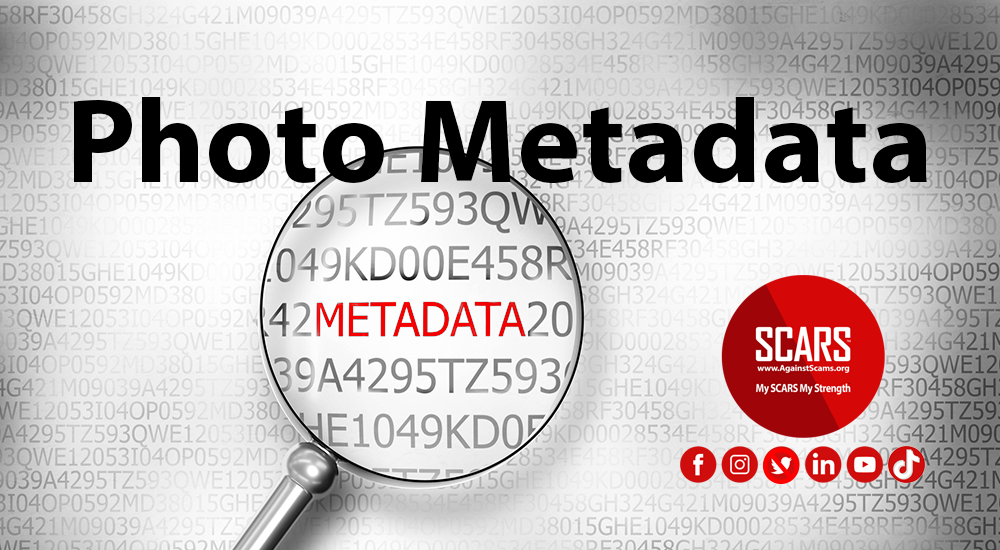Inside Those Stolen Photos! Metadata!
When you take a photo with your camera, the image itself isn’t the only thing that’s recorded. Other information like the date, time, camera model, and a host of other camera settings are also captured and stored within the image file.
Learn about Photo Metadata as a way to detect fakes
Hidden information inside digital photos can reveal much more than photographers and their subjects bargain for
According to the BBC:
When you take a photo, your smartphone or digital camera stores “metadata” within the image file. This automatically and parasitically burrows itself into every photo you take. It is data about data, providing identifying information such as when and where an image was captured, and what type of camera was used.
It is not impossible to expunge metadata, using freely available tools such as ExifTool. But many people don’t even realize the data is there, let alone how it might be used, so they don’t bother to do anything about it before they post images online. Some social media platforms remove information like geolocation (though only from public view), but many other websites do not.
This lack of awareness has proven useful for police investigators, to help them place unwitting criminals at a scene. But it also poses a privacy problem for law-abiding citizens if the authorities can track their activities through images on their camera and social media. And unfortunately, savvy criminals can use the same tricks as the police: if they can discover where and when a photo was taken, it can leave you vulnerable to crimes such as burglary or stalking.
But metadata is not the only thing hidden in your photos. There is also a unique personal identifier linking every image you capture to the specific camera used, but it’s one you’d probably never suspect. Even professional photographers might not realize or remember that it’s there.
To understand what this identifier is, you first have to understand how a photo is captured. Central to every digital camera, including those inside smartphones, is its imaging sensor. This is composed of a grid of millions of silicon “photosites”, which are cavities that absorb photons (light). Due to a phenomenon known as the photoelectric effect, the absorption of photons causes a photosite to eject electrons a bit like a nightclub bouncer.
The electrical charge of the electrons emitted from a photosite is measured and converted into a digital value. This results in a single value for each photosite, which describes the amount of light detected. And this is how a photo is formed. Or etymologically speaking, a drawing with light.
However, due to imperfections in the manufacturing process of imaging sensors, the dimensions of each photosite differs ever so slightly. And when coupled with the inherent inhomogeneity of their silicon material, the ability of each photosite to convert photons to electrons varies. This results in some photosites being more or less sensitive to light than they should be, independent of what is being photographed.
So, even if you used two cameras of the same make and model to snap a uniformly lit surface – where every point on the surface has the same brightness – there’d be subtle differences unique to each camera.
Much like snowflakes, no two imaging sensors are alike.
The different sensitivities of the photosites create a type of imperceptible image watermark. Although unintentional, it acts like a fingerprint, unique to your camera’s sensor, which is imprinted onto every photo you take. Much like snowflakes, no two imaging sensors are alike.
In the digital image forensics community, this sensor fingerprint is known as “photo response non-uniformity”. And it’s “difficult to remove even when one tries”, says Jessica Fridrich of Binghamton University in New York state. It’s inherent to the sensor, as opposed to measures, such as photo metadata, that are “intentionally implemented”, she explains.
Viewing Photo Metadata
- To Display the Photo’s Metadata go here: online metadata and exif viewer (metapicz.com)
- Or download the Exiftool onto your computer: ExifTool by Phil Harvey
However, this will not work on photos that have been posted to Facebook. Instead, ask the scammer to email the photos if possible. If there are still no metadata, it means they were copied from someone’s social media profile.
How to View EXIF Data in Windows
- Viewing EXIF data in Windows is easy. Just right-click on the photo in question and select “Properties”.
- Click on the “Details” tab and scroll down—you’ll see all kinds of information about the camera used, and the settings the photo was taken with.
How to View EXIF Data Using Preview in macOS
- On macOS, by opening up a photo in Preview. Once open, click on “Tools” up in the menu bar at the top.
- From there, select “Show Inspector”.
- Click on the “Exif” tab if it’s not already selected.
You’ll then see the advanced information about the photo, including the various camera settings that were used. It’ll even tell you if the flash was used or not.
You won’t see as much info (or you’ll see generic info) if your photo was taken on a smartphone, but you’ll see much more on DSLRs and other cameras. You can even see the serial number of the camera body.
Example Exif Metadata from a
Smartphone Camera Photo
Camera
| Make | samsung |
| Model | SM-N950U |
| Exposure | 1/421 |
| Aperture | 1.7 |
| Focal Length | 3.0 mm |
| ISO Speed | 40 |
| Flash | No Flash |
Maker Notes
| MakerNoteVersion | 0100 |
| DeviceType | Cell Phone |
| RawDataByteOrder | Little-endian (Intel, II) |
| RawDataCFAPattern | Swap |
| FaceDetect | Off |
EXIF
| ImageWidth | 3264 |
| ImageHeight | 2448 |
| Make | samsung |
| Model | SM-N950U |
| Orientation | Rotate 90 CW |
| XResolution | 72 |
| YResolution | 72 |
| ResolutionUnit | inches |
| Software | N950USQS8DTJ1 |
| ModifyDate | 2020:12:24 15:40:30 |
| YCbCrPositioning | Centered |
| ExposureTime | 1/421 |
| FNumber | 1.7 |
| ExposureProgram | Program AE |
| ISO | 40 |
| ExifVersion | 0220 |
| DateTimeOriginal | 2020:12:24 15:40:30 |
| CreateDate | 2020:12:24 15:40:30 |
| MaxApertureValue | 1.7 |
| MeteringMode | Center-weighted average |
| Flash | No Flash |
| FocalLength | 3.0 mm |
| FlashpixVersion | 0100 |
| ColorSpace | sRGB |
| ExifImageWidth | 3264 |
| ExifImageHeight | 2448 |
| ExposureMode | Auto |
| WhiteBalance | Auto |
| FocalLengthIn35mmFormat | 25 mm |
| SceneCaptureType | Standard |
| ImageUniqueID | V08QSJA01CM V08QSJA01CM |
| GPSLatitudeRef | South |
| GPSLatitude | 0 |
| GPSLongitudeRef | West |
| GPSLongitude | 0 |
PLEASE SHARE OUR ARTICLES WITH YOUR FRIENDS & FAMILY
HELP OTHERS STAY SAFE ONLINE – YOUR KNOWLEDGE CAN MAKE THE DIFFERENCE!
THE NEXT VICTIM MIGHT BE YOUR OWN FAMILY MEMBER OR BEST FRIEND!
By the SCARS™ Editorial Team
Society of Citizens Against Relationship Scams Inc.
A Worldwide Crime Victims Assistance & Crime Prevention Nonprofit Organization Headquartered In Miami Florida USA & Monterrey NL Mexico, with Partners In More Than 60 Countries
To Learn More, Volunteer, or Donate Visit: www.AgainstScams.org
Contact Us: Contact@AgainstScams.org




Leave A Comment